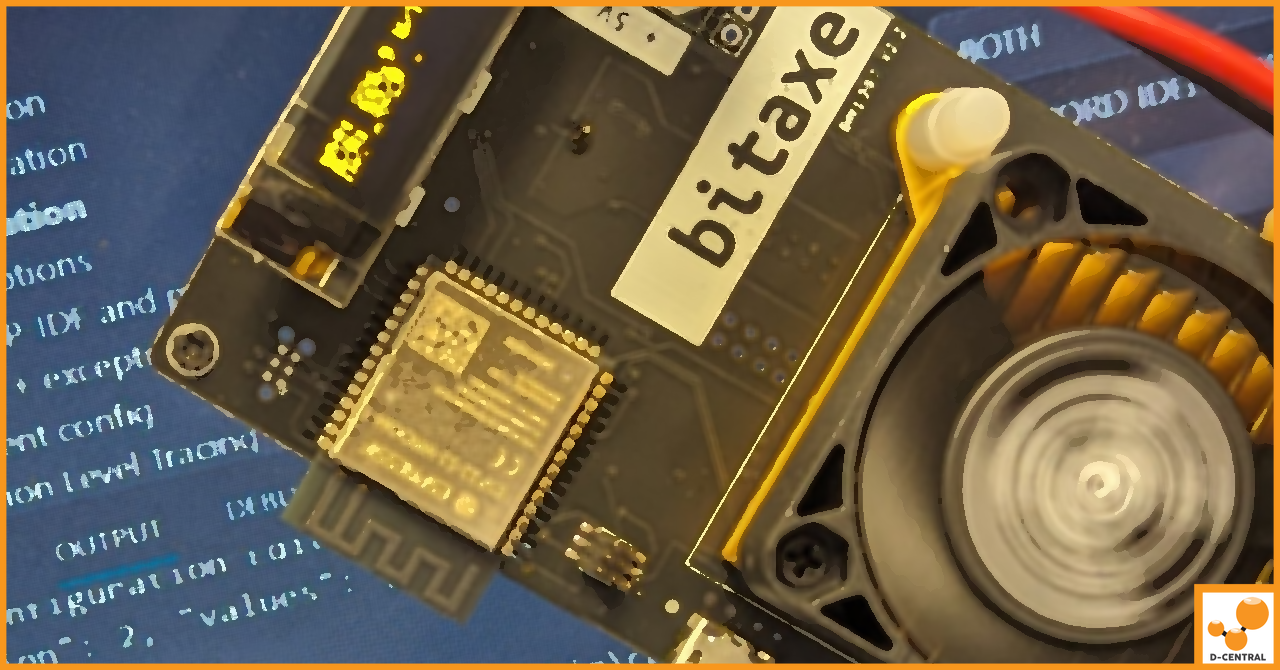
Open-Source Bitcoin Mining: How Bitaxe is Paving the Way
Bitcoin mining has come a long way since its inception in 2009. What started as a hobbyist activity, mining Bitcoin
4479 Desserte Nord Autoroute 440, Laval, QC H7P 6E2

In our previous article, Complete Guide to BM1397 ASIC Chip Selection and Replacement for Antminer 17 Series, we introduced you to the BM1397 chip, a key component in many Bitcoin mining rigs, and walked you through the process of replacing it. We hope you found that information useful and that it has served you well in your mining endeavors.
Today, we’re going to take things a step further. We’re going to delve deeper into the intricacies of the BM1397 chip, exploring its inner workings and understanding how to interact with it more effectively. This knowledge is not just for the curious; it’s essential for anyone serious about maximizing their Bitcoin mining efficiency.
The BM1397 chip, developed by Bitmain, is a testament to the evolution of Bitcoin mining technology. It’s designed to offer superior performance and efficiency, but to truly harness its potential, it’s crucial to understand how it works and how to interact with it.
In this article, we will explore key concepts such as the chip address, hash rate, PLL0 parameter, core registers, and the communication protocol. We’ll also delve into the processes of chip enumeration and setting the baud rate. Each of these elements plays a vital role in the operation of the BM1397 chip and, consequently, the efficiency of your Bitcoin mining operation.
So, whether you’re a seasoned Bitcoin miner or a tech enthusiast eager to learn more about the hardware that powers the Bitcoin network, this article is for you.
The BM1397 chip is a powerful piece of hardware that lies at the heart of many Bitcoin mining rigs. Developed by Bitmain, a leading name in the cryptocurrency mining industry, the BM1397 is an ASIC (Application-Specific Integrated Circuit) chip designed specifically for the purpose of mining Bitcoin.
ASIC chips like the BM1397 are custom-built for a particular use, rather than for general-purpose use. In this case, the BM1397 is engineered to perform the SHA-256 hashing algorithm used in the mining process of Bitcoin. This specialization allows it to perform its task more efficiently than general-purpose hardware, making it a crucial component in competitive Bitcoin mining.
The BM1397 chip is built using TSMC’s 7nm FinFET process, allowing for a significant increase in energy efficiency compared to previous models. This technological leap offers a higher hash rate, which is the speed at which a miner can solve the cryptographic puzzles that underpin the Bitcoin network. A higher hash rate increases the chances of solving these puzzles and, therefore, earning Bitcoin.
However, to truly harness the power of the BM1397 chip, it’s not enough to simply plug it in and let it run. It’s crucial to understand its inner workings, how to interact with it, and how to optimize its performance. This includes understanding concepts like chip address, hash rate, and PLL0 parameter, as well as processes like chip enumeration and setting the baud rate.
In the following sections, we’ll delve deeper into these topics, providing you with the knowledge you need to maximize your Bitcoin mining efficiency. Whether you’re a seasoned miner looking to optimize your operation or a newcomer to the field, understanding the BM1397 chip is a crucial step on your Bitcoin mining journey.
A chip address is a logical identifier used to interact with a specific chip in a chain. When the chips are reset, they all have a logical address of 0. This means that if you were to send a command to address 0, all chips would accept and execute that command because they all share the same address. To interact with a specific chip, you need to assign a unique address to each chip. This process is known as “enumeration”.
Here’s how the enumeration process works:
It’s important to note that the addresses don’t have to be contiguous. For example, they could be assigned with an increment of 8 or 4. This is used to divide the total nonce space evenly between the chips on the chain. All chips will add their own address to the nonce they are hashing. This ensures that each chip works on a different part of the nonce space, which increases the efficiency of the mining process.
In summary, understanding the concept of a chip address and the process of chip enumeration is crucial for interacting with and controlling the individual chips in a mining ASIC. By assigning unique addresses to each chip, you can send commands to specific chips and have them work on different parts of the nonce space, which can help optimize the mining process.
The hash rate is a measure of computational power. In the context of Bitcoin mining, it refers to the speed at which a miner can perform the operations in the Bitcoin code, specifically the SHA-256 hashing algorithm. The higher the hash rate, the more operations a miner can perform per second, and therefore, the higher the chance of solving the cryptographic puzzle that underpins the Bitcoin network. Solving this puzzle is how miners validate transactions and add them to the blockchain, earning Bitcoin in the process.
In the context of the BM1397 chip, the hash rate is calculated based on a base clock, specifically the PLL0 (Phase-Locked Loop 0). The PLL0 is a control system that generates an output signal whose phase is related to the phase of an input signal. It’s used as the base clock for hash rate calculation.
The hash rate value is given in a 2^24 unit. This is a binary representation, which is common in computing and digital systems. The hash rate value is stored in a specific register (address = 0x04), and its reset value is 0x80000000.
It’s important to note that the hash rate is not the only factor that determines mining success. Other factors, such as the difficulty of the puzzles, the efficiency of the mining hardware, and the cost of electricity, also play a significant role. However, understanding and optimizing the hash rate is a key part of maximizing the effectiveness of a mining operation.
In summary, the hash rate is a critical concept in Bitcoin mining. It measures the speed at which a miner can solve the cryptographic puzzles required to earn Bitcoin. Understanding how it’s calculated in the BM1397 chip can help you optimize your mining operation and increase your chances of earning Bitcoin.
In the operation of the BM1397 chip, the PLL0 parameter plays a crucial role. PLL stands for Phase-Locked Loop, a control system that generates an output signal whose phase is related to the phase of an input signal. In the context of the BM1397 chip, PLL0 is used as the base clock for hash rate calculation.
The PLL0 Parameter is stored in a specific register (address = 0x08), and its reset value is 0xC0600161. The frequency of PLL0 is calculated using the following formula:
fPLL0 = fCLKI * FBDIV / (REFDIV * POSTDIV1 * POSTDIV2)
Here’s what each term in the formula means:
One important condition for this formula is that POSTDIV1 must be greater than or equal to POSTDIV2.
By adjusting the values of FBDIV, REFDIV, POSTDIV1, and POSTDIV2, you can control the frequency of PLL0, which in turn affects the hash rate of the BM1397 chip. This allows you to optimize the performance of the chip for your specific mining needs.
In summary, the PLL0 parameter is a crucial part of the BM1397 chip’s operation. By understanding its role and how to calculate its frequency, you can better control the chip’s hash rate and optimize your Bitcoin mining operation.
Core registers are a fundamental part of any CPU’s operation, including the BM1397 chip. They are essentially small storage areas within the CPU that hold data the CPU is currently processing. Each register has a specific function and can be read or written to, depending on its design.
In the context of the BM1397 chip, it provides a map of the core registers. These registers control various aspects of the chip’s operation. Here are some of the key core registers:
To read or write to these registers, you need to use the “Write Register” or “Read Register” commands, respectively. The document provides detailed instructions on how to do this.
Understanding these core registers and how to interact with them can be crucial for optimizing the performance of the BM1397 chip and, by extension, your mining operation. They allow you to control various aspects of the chip’s operation, from the clock delay to the hash clock, and can provide valuable information about the chip’s status and performance.
The communication protocol for the BM1397 chip is a fundamental aspect of controlling and interacting with the chip. It’s based on UART (Universal Asynchronous Receiver/Transmitter), a common hardware interface for serial communication. UART allows for data to be transmitted and received between the chip and the controlling software.
Here are the key elements of the communication protocol:
The protocol involves sending commands to the chip and receiving responses. All commands have a fixed 2-byte preamble (0x55 0xAA), and the type of command is determined by the TYPE field. For example, TYPE = 1 is used to send a job, and TYPE = 2 is used to send a command. The ALL field determines whether the command is sent to a single chip or all chips on the chain.
Responses from the chip also have a fixed 2-byte preamble (0xAA 0x55), and the type of response is determined by the TYPE field. For example, TYPE = 0 is a response to a command, and TYPE = 4 is a response to a job (nonce).
Understanding this communication protocol is crucial for interacting with the BM1397 chip and controlling its operation. It allows you to send jobs to the chip, set the chip address, read and write registers, and handle responses from the chip. By mastering this protocol, you can effectively control your mining operation and optimize the performance of your BM1397 chips.
Commands and responses are integral to the communication between the user and the BM1397 chip. They allow you to control the chip’s operation, send jobs to the chip, and handle responses from the chip. The communication is done via UART on the chip’s CI (Command Input) and RO (Response Output) pins.
Commands:
Commands have a fixed structure. They start with a 2-byte preamble (0x55 0xAA), followed by a TYPE field that determines the type of command. Here are some of the key types of commands:
The ALL field in the command determines whether the command is sent to a single chip or all chips on the chain. If ALL = 1, the command is sent to all chips. If ALL = 0, the command is sent to a single chip, determined by the ADDR (address) field.
Responses:
Responses from the chip also have a fixed structure. They start with a 2-byte preamble (0xAA 0x55), followed by a TYPE field that determines the type of response. Here are some of the key types of responses:
Understanding the structure of commands and responses is crucial for interacting with the BM1397 chip. It allows you to control the chip’s operation, send jobs to the chip, and handle responses from the chip. By mastering this aspect of the communication protocol, you can effectively control your mining operation and optimize the performance of your BM1397 chips.
The baud rate is a measure of the speed of data transfer in a communication system. In the context of the BM1397 chip, it refers to the speed at which data is transferred between the chip and the controlling software via UART (Universal Asynchronous Receiver/Transmitter). The default baud rate for the BM1397 chip is 115200 bps (bits per second).
To achieve a higher hash rate, the communication baud rate needs to be increased. This allows for faster data transfer, which can help improve the efficiency of the mining process. However, increasing the baud rate requires a careful process to ensure that the chip can handle the increased speed and that data is not lost or corrupted.
Here’s how the process of setting the baud rate works:
It’s important to note that increasing the baud rate can put more strain on the chip and the controlling software, so it should be done carefully and with consideration of the capabilities of your hardware and software. However, if done correctly, it can help improve the efficiency of your mining operation.
In this comprehensive guide, we’ve delved deep into the intricacies of the BM1397 chip, a critical component in Bitcoin mining. We’ve explored the chip’s address and the process of enumeration, the concept of hash rate and how it’s calculated, the role of the PLL0 parameter, the function of core registers, the communication protocol with the chip, the structure of commands and responses, the process of chip enumeration, and the importance of setting the baud rate.
Understanding these aspects of the BM1397 chip is crucial for anyone involved in advanced Bitcoin mining operations. By mastering these concepts, you can optimize your mining operation, increase your hash rate, and ultimately, maximize your Bitcoin earnings.
At D-Central, we’re committed to providing you with the knowledge and tools you need to succeed in the world of Bitcoin mining. Whether you’re a DIY miner sourcing your own parts or a large-scale operation in need of comprehensive mining support and outsourcing solutions, we’re here to help.
If you’re interested in learning more about the BM1397 chip or need assistance with your mining operation, don’t hesitate to reach out to us. Our team of experts is ready to provide consultation, sourcing of mining hardware, hosting mining operations, ASIC repairs, maintenance training, and more. Let us help you optimize your mining operation and maximize your Bitcoin earnings. Contact us today to get started.
What is the BM1397 chip and its significance in Bitcoin mining?
The BM1397 chip, developed by Bitmain, is a unique piece of hardware that is key to many Bitcoin mining rigs. It’s an ASIC chip designed specifically to perform the SHA-256 hashing algorithm used in the mining process for Bitcoin.
What are ASIC chips used for?
ASIC chips like the BM1397 are custom-built for a specific use rather than for general-purpose. It is uniquely designed to effectively and efficiently carry out the task it is created for, in this case, mining Bitcoin.
What is the hash rate relative to Bitcoin Mining?
The hash rate measure how fast a miner can perform operations in the Bitcoin code, specifically the SHA-256 hashing algorithm. The higher the hash rate, the higher is the chance of miners to solve the underlying cryptographic puzzles, hence earning Bitcoin.
What is the PLL0 parameter in BM1397 chip operations?
PLL stands for Phase-Locked Loop, a control system that creates an output signal whose phase relies on the phase of an input signal. For BM1397 chip, PLL0 is used as the base clock for hash rate calculation.
Why is the process of assigning chip address and enumeration important in Bitcoin mining?
Assigning a unique address to each chip known as “enumeration” is a crucial process in the management of a chain of BM1397 chips. It makes interacting with each chip individually possible which helps optimize the overall mining process.
What is baud rate and how does it affect Bitcoin mining?
The baud rate in the context of the BM1397 Chip refers to the speed at which data is transferred between the chip and the controlling software. A higher baud rate leads to a faster data transfer rate which potentially improves the efficiency of the mining process.
What does communication protocol entail in the context of BM1397 chip?
The communication protocol, in this setting, entails the transmission of commands to the chip and receiving responses which is done via UART on the chip’s CI and RO pins. The protocol allows a user to control a chip’s operation, send jobs to the chip, and receive responses from the chip.
Can I optimize my Bitcoin mining operation by understanding the functions of the BM1397 chip?
Absolutely! By understanding key concepts such as chip address, hash rate, PLL0 parameter, and processes like chip enumeration and setting the baud rate, you will be able to optimize the performance of your BM1397 chip, therefore maximizing your Bitcoin mining efficiency.
DISCLAIMER: D-Central Technologies and its associated content, including this blog, do not serve as financial advisors or official investment advisors. The insights and opinions shared here or by any guests featured in our content are provided purely for informational and educational purposes. Such communications should not be interpreted as financial, investment, legal, tax, or any form of specific advice. We are committed to advancing the knowledge and understanding of Bitcoin and its potential impact on society. However, we urge our community to proceed with caution and informed judgment in all related endeavors.
Related Posts

Bitcoin mining has come a long way since its inception in 2009. What started as a hobbyist activity, mining Bitcoin

As we step into a new era of connectivity, the fusion of 5G networks and Bitcoin mining is reshaping the

In recent years, cryptocurrency mining has transformed from a niche hobby into a major industrial activity, largely due to the